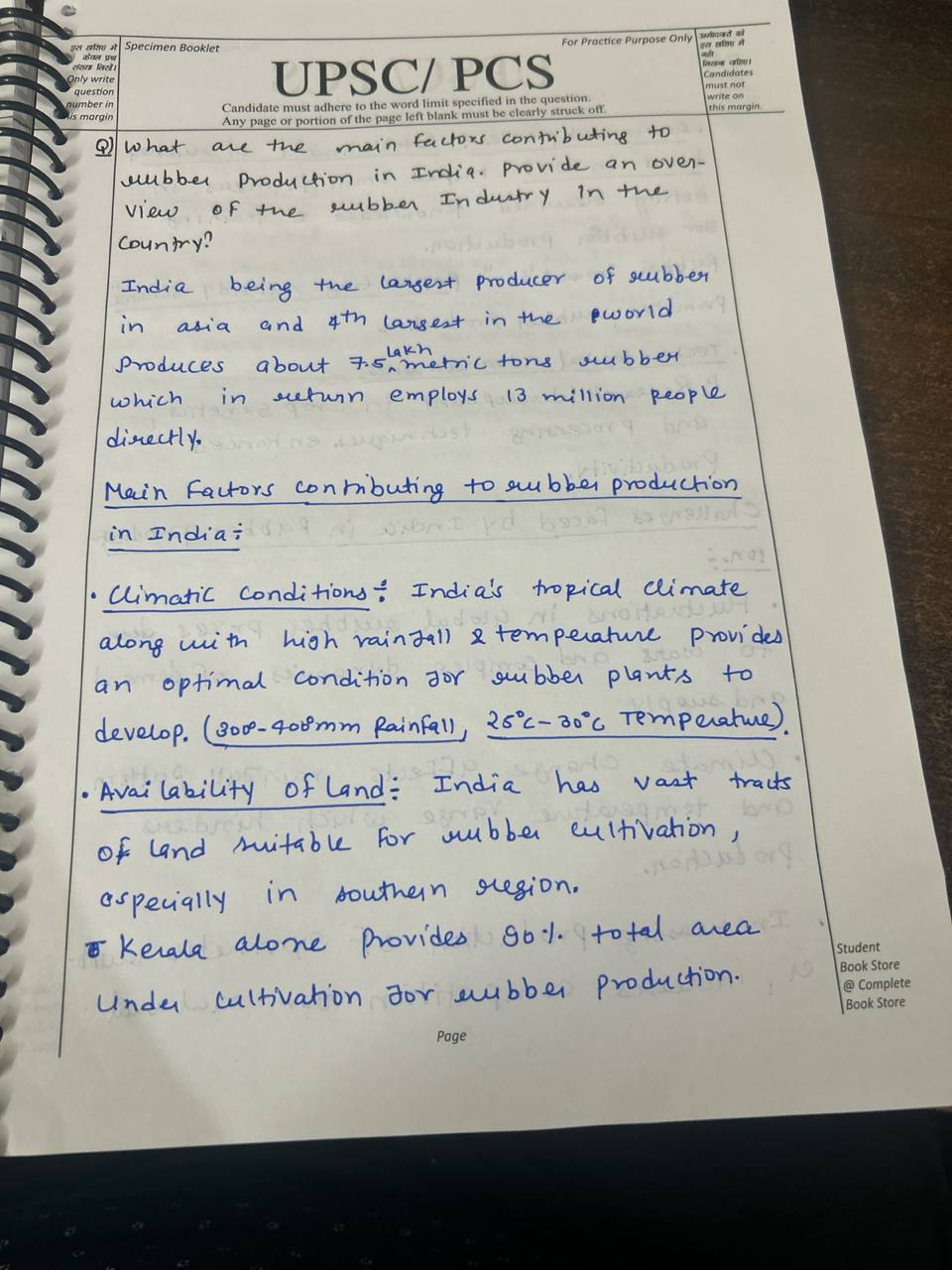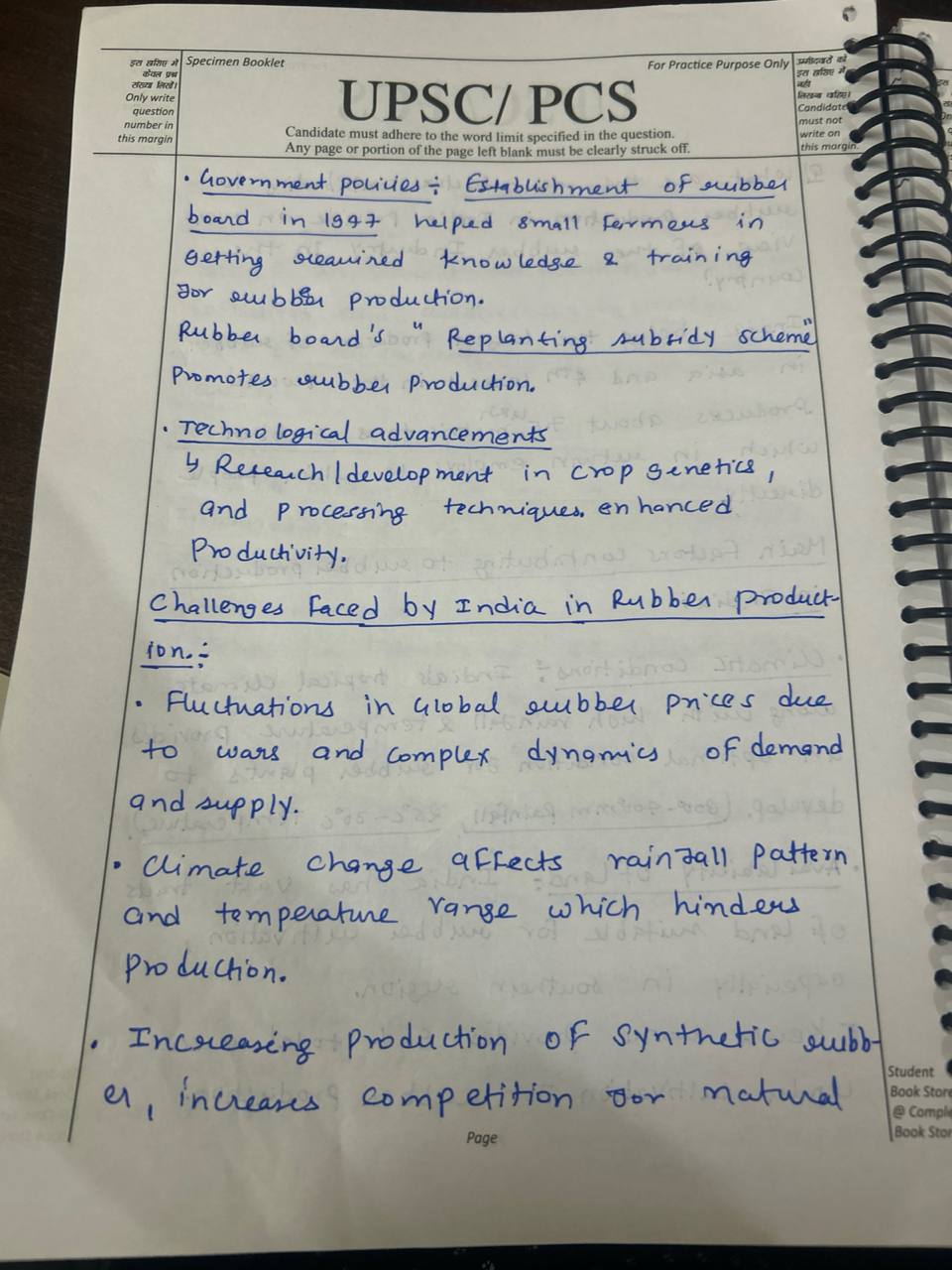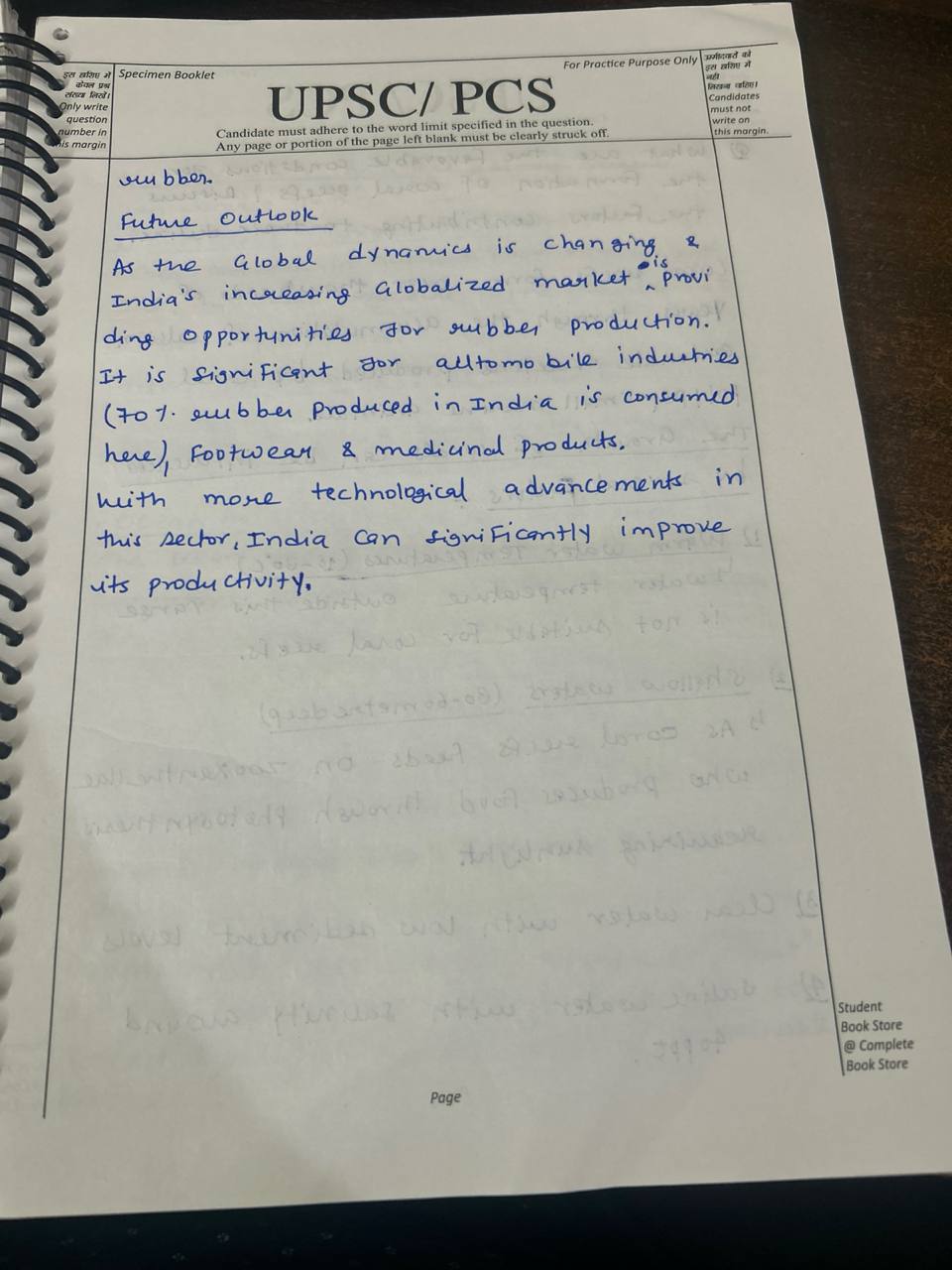Home/upsc: mineral resource
- Recent Questions
- Most Answered
- Answers
- No Answers
- Most Visited
- Most Voted
- Random
- Bump Question
- New Questions
- Sticky Questions
- Polls
- Followed Questions
- Favorite Questions
- Recent Questions With Time
- Most Answered With Time
- Answers With Time
- No Answers With Time
- Most Visited With Time
- Most Voted With Time
- Random With Time
- Bump Question With Time
- New Questions With Time
- Sticky Questions With Time
- Polls With Time
- Followed Questions With Time
- Favorite Questions With Time

Assess the contribution of remote sensing and Geographic Information Systems (GIS) in the management of natural resources in India. (200 words)
Model Answer Introduction Remote sensing and Geographic Information Systems (GIS) are vital tools in managing natural resources in India. These technologies allow for the collection, analysis, and management of spatial data, enabling informed decision-making in the sustainable use and conservation oRead more
Model Answer
Introduction
Remote sensing and Geographic Information Systems (GIS) are vital tools in managing natural resources in India. These technologies allow for the collection, analysis, and management of spatial data, enabling informed decision-making in the sustainable use and conservation of resources.
Role of Remote Sensing and GIS in Managing Natural Resources
Remote sensing provides accurate satellite imagery to map land cover types, enabling the monitoring of land use changes and identifying encroachments. This data helps in planning for sustainable land management and conservation.
Remote sensing helps monitor forest cover, assess deforestation, and detect illegal activities like logging. It also assists in reforestation efforts by providing up-to-date information on forest health and density.
Remote sensing assists in monitoring water availability, quality, and stress areas, crucial for water resource management. It aids in identifying regions prone to droughts or water scarcity.
Remote sensing provides real-time data for monitoring crop health, yield estimation, and detecting areas affected by pests, diseases, or drought. It aids farmers in making informed decisions about agricultural practices.
Remote sensing and GIS support disaster management by providing timely, accurate information on natural disasters like floods, cyclones, and earthquakes. This helps in real-time assessment and decision-making during disaster response.
Conclusion
Remote sensing and GIS play an essential role in the management of natural resources in India. They support informed decision-making, enhance resource conservation, and contribute to sustainable development and disaster resilience.
See lessCritically analyze the different resources of the Indian Ocean that can be utilized to address the resource crisis in India. (200 words)
Model Answer Introduction The Indian Ocean is a crucial economic and strategic region that plays a pivotal role in global trade and commerce. This region is rich in resources, including energy reserves, fisheries, and minerals, all of which can be harnessed to help address India's growing resource cRead more
Model Answer
Introduction
The Indian Ocean is a crucial economic and strategic region that plays a pivotal role in global trade and commerce. This region is rich in resources, including energy reserves, fisheries, and minerals, all of which can be harnessed to help address India’s growing resource crisis. A critical analysis of these resources highlights their potential and the challenges associated with their sustainable utilization.
1. Energy Resources:
The Indian Ocean is home to significant offshore oil and gas reserves, which are vital for meeting India’s energy demands. One example is the Bombay High oil fields, which have been a key contributor to India’s energy security. Additionally, the KG-D6 gas field, operated by Reliance Industries, has significantly reduced India’s dependence on energy imports. Expanding exploration and development of offshore oil and gas fields could further alleviate the resource crisis and contribute to India’s energy independence.
2. Fisheries and Marine Biodiversity:
The Arabian Sea, a part of the Indian Ocean, is known for its rich fish stocks, including tuna, mackerel, and shrimp. Fisheries provide a critical source of protein for India’s growing population. By implementing sustainable fishing practices, such as mesh size regulations and fishing quotas, India can meet its seafood demands while preserving marine biodiversity. This approach supports both economic growth and the long-term health of marine ecosystems.
3. Mineral Resources:
The Central Indian Ocean Basin contains vast reserves of manganese nodules, rich in metals like manganese, nickel, and cobalt. These minerals are essential for various industries, including electronics and battery production. Exploration initiatives, such as those led by the International Seabed Authority, are essential for meeting India’s growing demand for these critical minerals, reducing dependence on imports.
4. Seabed Resources:
The deep seabed of the Indian Ocean holds polymetallic nodules, which are rich in valuable metals like nickel, copper, and cobalt. The National Institute of Ocean Technology is conducting research on deep-sea mining, ensuring environmental sustainability. Responsible mining practices can provide India with access to these critical resources while minimizing ecological damage.
5. Blue Economy Opportunities:
The Indian Ocean offers numerous opportunities for the blue economy, including maritime trade, port development, and coastal tourism. Ports like the Jawaharlal Nehru Port Trust play a key role in enhancing trade. Additionally, the region’s potential for biotechnology, including pharmaceutical research and bioprospecting, presents a new frontier for economic development.
Conclusion
While the Indian Ocean offers numerous resources that can significantly address India’s resource crisis, challenges such as overfishing, illegal fishing practices, inadequate regulations, and environmental risks, particularly in deep-sea mining, must be addressed. For sustainable resource utilization, India needs strict regulations, comprehensive environmental assessments, investment in clean energy alternatives, and technological advancements. Robust policy support and ongoing research will be crucial for balancing economic growth with environmental preservation.
See lessAnalyze the geographical challenges associated with mining critical minerals in India and evaluate the geopolitical implications of India's efforts to establish a reliable supply chain for these vital resources. (200 words)
Model Answer Introduction Critical minerals are indispensable for modern technology, forming the backbone of renewable energy systems, semiconductors, and advanced batteries. In India, these minerals are pivotal for the transition to sustainable energy, but challenges in their mining and supply chaiRead more
Model Answer
Introduction
Critical minerals are indispensable for modern technology, forming the backbone of renewable energy systems, semiconductors, and advanced batteries. In India, these minerals are pivotal for the transition to sustainable energy, but challenges in their mining and supply chain management remain significant.
Geographic Challenges in Mining Critical Minerals in India
Many critical mineral reserves, like lithium and cobalt, are buried deep in inaccessible terrains such as the forests of Odisha or Arunachal Pradesh. Dense vegetation, remote locations, and the absence of infrastructure create logistical difficulties. For example, Arunachal Pradesh holds cobalt reserves that remain untapped due to such challenges.
Coastal states like Kerala and Tamil Nadu, rich in atomic minerals, have strict ecological preservation laws that hinder mining activities. Similarly, environmental concerns limit alluvial mining in river basins.
Acquiring land for mining is often delayed by complex procedures and tribal rights issues. For instance, uranium deposits in Meghalaya remain largely unexploited due to bureaucratic and legal hurdles.
The Naxalite insurgency in mineral-rich belts of central and eastern India poses significant risks. For example, security challenges in Jharkhand and Chhattisgarh affect bauxite and iron ore mining operations.
Limited rail and road networks connecting mines to ports raise transportation costs. Moreover, outdated mining techniques and insufficient R&D hinder efficient mineral extraction.
Geopolitical Implications of India’s Efforts
Exploiting domestic reserves can decrease reliance on China for lithium and cobalt, enhancing India’s strategic autonomy in critical sectors like defense and manufacturing.
Investments in mineral-rich regions like Africa and Latin America bolster India’s global partnerships, expanding its influence in international supply chains.
Becoming a leader in processing and integrating critical minerals into advanced industries can position India as a key player in global value chains.
India’s proactive participation in multilateral forums like BRICS helps advocate for fair trade, transparency, and pricing regulations in critical mineral markets.
Critical minerals are vital for achieving India’s renewable energy targets, such as the 450 GW capacity goal by 2030, reducing greenhouse gas emissions.
Way Forward
Encourage both public and private sector involvement in exploring domestic mineral reserves.
Adopt methods to minimize environmental and social impacts.
Invest in R&D to improve recycling capabilities and reduce dependency on raw mineral imports.
Establish traceability for ethical sourcing of minerals.
Prioritize minerals, incentivize domestic production, and align mining practices with global sustainability standards.
Conclusion
By addressing geographic challenges and leveraging geopolitical opportunities, India can reduce its external dependencies and become a major stakeholder in sustainable critical mineral value chains. This transformation is crucial for India’s ambition to emerge as a manufacturing and renewable energy powerhouse.
See lessWhat are the main lithium reserves in India, and what challenges are associated with their extraction? Additionally, how can lithium contribute to India's shift towards renewable energy? (200 words)
Model Answer India has recently discovered significant lithium reserves, particularly in the Jammu and Kashmir (J&K) region, where the Geological Survey of India (GSI) has identified an "inferred" resource of 5.9 million tonnes. Other exploration projects have been carried out across various staRead more
Model Answer
India has recently discovered significant lithium reserves, particularly in the Jammu and Kashmir (J&K) region, where the Geological Survey of India (GSI) has identified an “inferred” resource of 5.9 million tonnes. Other exploration projects have been carried out across various states including Bihar, Chhattisgarh, Himachal Pradesh, Jharkhand, Madhya Pradesh, Meghalaya, Karnataka, and Rajasthan. The GSI has also undertaken five additional projects in Arunachal Pradesh, Andhra Pradesh, and Rajasthan to explore lithium and its associated minerals.
Challenges in Lithium Extraction
Lithium’s Role in India’s Transition to Renewable Energy
To fully capitalize on lithium’s potential, the Indian government should streamline the regulatory process, invest in mining infrastructure, and explore international partnerships, such as with Australia, to gain expertise in lithium extraction.
See lessWhy are resource efficiency and circular economy important for a developing country like India? (200 words)
Model Answer India, as a developing nation, faces numerous challenges related to resource scarcity, environmental degradation, and the need for sustainable economic growth. Resource efficiency (RE) and circularity play a crucial role in addressing these issues, making them especially significant forRead more
Model Answer
India, as a developing nation, faces numerous challenges related to resource scarcity, environmental degradation, and the need for sustainable economic growth. Resource efficiency (RE) and circularity play a crucial role in addressing these issues, making them especially significant for India’s development.
1. Decoupling Economic Growth from Resource Use
India’s resource extraction rate is nearly three times higher than the global average. Adopting RE&C can help reduce this high extraction rate, allowing the country to continue economic growth without excessively depleting natural resources. By improving resource efficiency, India can maximize the output per unit of resources consumed, minimizing waste while maintaining economic expansion.
2. Resource Independence
India, with its growing industrialization and population, faces increasing resource scarcity, which is exacerbated by rapid demand and global supply chain vulnerabilities. Circularity and resource efficiency can reduce India’s dependence on imported raw materials by making better use of existing resources through recycling, reuse, and refurbishment. This leads to greater self-sufficiency in essential materials, mitigating risks related to global supply disruptions.
3. Enhanced Competitiveness
Efficient use of resources can significantly cut costs for industries. Raw material costs are a major expenditure for Indian industries, and improving resource efficiency can boost their competitiveness. The circular economy model is expected to generate significant financial benefits—around $624 billion annually by 2050 for India, contributing to increased profitability.
4. Environmental and Economic Benefits
Adopting resource-efficient practices helps India reduce environmental degradation and waste production, particularly in energy sectors, where solar and wind energy contribute to reduced fossil fuel reliance. A circular economy approach can also reduce greenhouse gas emissions by 44%, aligning with India’s sustainable development goals.
5. Job Creation and Economic Growth
The transition to a circular economy will create new employment opportunities, particularly in the repair, maintenance, and recycling sectors. It is also expected that India’s circular economy could contribute up to $45 billion by 2030, promoting long-term economic growth.
Conclusion
See lessResource efficiency and circularity are vital for achieving sustainable development goals and advancing India’s economy, making these principles essential for India’s path to becoming a five trillion-dollar economy.
What are non-metallic minerals? Discuss their uses and distribution across India. (200 words)
Model Answer Non-Metallic Minerals: Uses and Distribution in India Non-metallic minerals do not contain metals and are categorized into fuel and non-fuel minerals. Key examples include coal, petroleum, natural gas, mica, limestone, and marble. Uses of Non-Metallic Minerals: Coal is primarily used foRead more
Model Answer
Non-Metallic Minerals: Uses and Distribution in India
Non-metallic minerals do not contain metals and are categorized into fuel and non-fuel minerals. Key examples include coal, petroleum, natural gas, mica, limestone, and marble.
Uses of Non-Metallic Minerals:
Distribution Across India:
- Coal: Found mainly in the Damodar Valley (Jharia, Raniganj) and coastal regions (Tamil Nadu, Gujarat).
- Petroleum: Primarily in Assam, Gujarat, and the Krishna-Godavari basin.
- Natural Gas: Reserves are abundant in Mumbai High, Cambay basin, and Krishna-Godavari basin.
- Mica: Predominantly in Jharkhand (Koderma-Hazaribagh) and Rajasthan.
- Limestone: Major deposits in Rajasthan, Madhya Pradesh, and Andhra Pradesh (Source: Geological Surveys of India).
See lessWhat are the main factors contributing to rubber production in India? Provide an overview of the rubber industry in the country. (200 words)



See lessAnalyze the role of technology in improving efficiency and reducing environmental harm in India's mining sector.
Technology plays a crucial role in enhancing efficiency and reducing environmental harm in India’s mining sector. Advances in technology are helping to address many of the challenges associated with mineral extraction, including resource management, safety, and environmental impacts. Here’s an analyRead more
Technology plays a crucial role in enhancing efficiency and reducing environmental harm in India’s mining sector. Advances in technology are helping to address many of the challenges associated with mineral extraction, including resource management, safety, and environmental impacts. Here’s an analysis of how technology is influencing these areas:
1. Enhancing Efficiency
2. Reducing Environmental Harm
3. Case Studies and Examples
4. Policy and Strategic Recommendations
Conclusion
Technology plays a transformative role in improving efficiency and reducing environmental harm in India’s mining sector. By leveraging advanced exploration techniques, automation, energy-efficient technologies, and innovative pollution control measures, the mining industry can enhance productivity while minimizing its environmental footprint. Continued investment in technology, research, and regulatory frameworks is essential to achieving a sustainable and efficient mining sector that balances economic growth with environmental conservation.
See lessDiscuss the challenges of balancing economic growth with environmental conservation in India's mineral resource management.
Balancing economic growth with environmental conservation in India’s mineral resource management presents several complex challenges. The country’s growing economy relies heavily on mineral resources, but the extraction and processing of these resources can lead to significant environmental impacts.Read more
Balancing economic growth with environmental conservation in India’s mineral resource management presents several complex challenges. The country’s growing economy relies heavily on mineral resources, but the extraction and processing of these resources can lead to significant environmental impacts. Here’s an in-depth discussion of the challenges involved:
1. Economic vs. Environmental Priorities
2. Regulatory and Policy Challenges
3. Environmental Management and Sustainable Practices
4. Community and Social Impacts
5. Policy and Strategic Recommendations
Conclusion
Balancing economic growth with environmental conservation in India’s mineral resource management involves addressing a range of complex challenges. While mineral resources are vital for economic development and employment, their extraction and processing can have significant environmental impacts. Achieving this balance requires effective regulatory frameworks, sustainable mining practices, technological innovation, and stakeholder engagement. By adopting a holistic approach and implementing strategic policies, India can work towards managing its mineral resources in a way that supports both economic growth and environmental sustainability.
See lessHow does the informal sector impact mineral extraction and labor conditions in India’s mining industry?
The informal sector plays a significant role in India’s mining industry, impacting mineral extraction processes and labor conditions in various ways. Here’s an analysis of its impact: 1. Role of the Informal Sector in Mineral Extraction Prevalence and Scope Extent of Informality: A substantial portiRead more
The informal sector plays a significant role in India’s mining industry, impacting mineral extraction processes and labor conditions in various ways. Here’s an analysis of its impact:
1. Role of the Informal Sector in Mineral Extraction
2. Impact on Labor Conditions
3. Environmental and Social Implications
4. Regulatory and Policy Challenges
5. Case Studies and Examples
Conclusion
The informal sector has a significant impact on mineral extraction and labor conditions in India’s mining industry. While it provides economic opportunities and employment, it also contributes to poor labor conditions, environmental degradation, and social conflicts. Addressing these challenges requires a comprehensive approach that includes formalizing the sector, improving regulatory oversight, supporting sustainable practices, and enhancing labor protections. By addressing these issues, India can work towards a more sustainable and equitable mining industry that benefits both workers and the environment.
See less